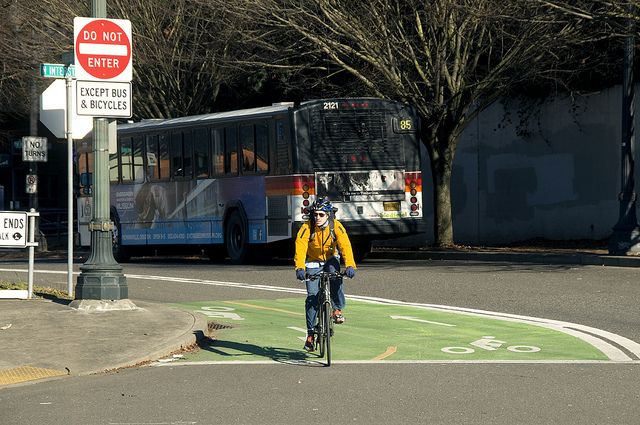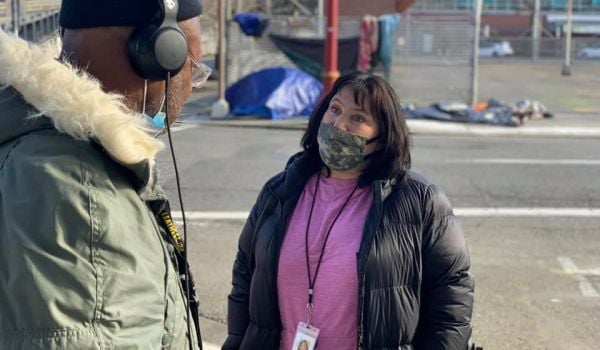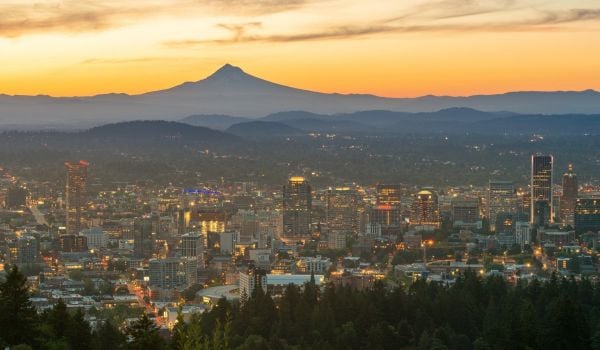It’s become a cliché that Portland is America’s most livable city, a hotbed of innovation when it comes to green policies, public spaces, pedestrian amenities, transit, public spaces, and, of course, bicycles. In fact some people are growing weary (and the rest of us envious) of hearing about how great things are in Oregon’s largest city.
But clichés often turn out to be true. After spending several days exploring Portland as part of a Bikes Belong Foundation-sponsored transportation workshop for city officials from across the country, I must admit that Portland offers a wealth of inspiration and practical tips for how we can make our towns more bikeable, vital and fun.
Yet, as the delegation of transportation leaders from Chicago, Houston, Seattle, Minneapolis and Salt Lake City discovered while biking across the city, Portland is no Ecotopia. Local bikers still contend with roaring traffic on crowded streets and motorists who park illegally in bike lanes or honk for no apparent reason. As Laura Spanjian, Sustainability Director in the Houston mayor’s office, observed, “I was surprised there’s so much traffic. Actually that made me hopeful—that we can do some of the same things in Houston even with all our traffic.”
“Portland is still an American city,” explains Roger Geller, the city’s Bicycle Coordinator. “But since the 1990s, we’ve tried to make biking safer and more comfortable, and good things have happened. What you see are the results of a 20-year effort to promote biking.”
The accomplishments are impressive. Today Portland sports the highest share of bicycle commuters (6-8 percent) of any large U.S. city. It’s also the only large city to earn The League of American Bicyclists’ coveted platinum status as a bicycle-friendly city. (The others in that league are Boulder, Colorado, and Davis, California.) “We don’t see the bicycle as simply an end in itself,” notes Catherine Ciarlo, Transportation Director for Portland Mayor Sam Adams, “but the means to a clean, green, vital city.” She points proudly to Portland’s 314 miles of bikeways, which fall into four categories:
- Bike lanes, separated from traffic by a painted line (202 miles).
- Neighborhood greenways, residential streets where bikes take priority over cars; also known as bike boulevards (36 miles).
- Bike paths, off-street facilities, typically multi-use, that wind through parks or follow old rail lines (76 miles).
- Cycle tracks, a bike-only space along a busy street where cyclists are physically buffered from cars by a median, grade separation or wide strip of painted pavement (just under a mile completed, but more are underway).
Biking is healthy for the economy as well as people
The city is undertaking ambitious new plans to boost biking even more over the next twenty years. Calculated to cost $600 million between now and 2030—a pricetag that’s drawn some criticism in this era of tight municipal budgets—Ciarlo lauds the 2030 Bicycle Master Plan vision as “a good investment” that accounts for no more than five percent of the city’s overall transportation budget.
“The progress we’ve made in increasing biking came at a very low cost compared to other transportation funding,” she explains. Geller adds that between 2001 and 2007, bike facilities comprised less than one percent of Portland’s overall capital expenditures for transportation despite carrying between 3% and 7% of all trips.
Bikes actually pump a surprising amount of money into the local economy, according to Ciarlo. It’s a selling point for attracting tourists, and a recent study from CEOs for Cities shows that Portland keeps $800 million that would drain out-of-town if local residents drove cars at the same rate as an average U.S. city. The conclusion is that by spending less money on gas and less time on the highway, Portlanders have more of both to spend at local businesses.
Mia Birk, Portland’s Bicycle Coordinator from 1993-1999 and now CEO of Alta Planning+Design, points to a study showing that bikes now account for $100 million in local economic activity each year (including retail sales, national firms based here, and proceeds from bike events and rides), and are directly responsible for almost 1000 jobs in the region. She notes that a similar study in Wisconsin found a $1.5 billion boost for the state economy.
Part II: Coming tomorrow!
Jay Walljasper—author of The Great Neighborhood Book—writes, speaks and consults about creating strong communities.
















